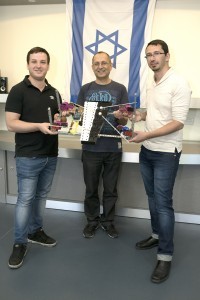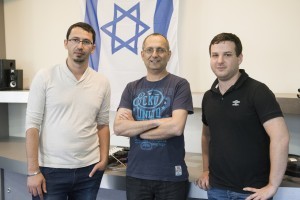Robotic Hatikva

1. Students Igor Kantor (right) and Eli Zalianski (left) with their advisor Koby Kohai, head of the Control Robotics & Machine Learning Lab at the Technion Faculty of Electrical Engineering, advised the students on the project, and the robotic xylophone.
In the late 19th century, when he wrote Hatikva, which became the national anthem of the State of Israel, it is doubtful whether poet Naphtali Herz Imber dreamed that a robotic xylophone built by Technion students would play the national anthem in honor of Israel’s 68th Independence Day.
As part of their final project, Eli Zalianski (27) and Igor Kantor (28), undergraduate students at the Technion Faculty of Electrical Engineering, built a system of robotic arms for playing the xylophone. The system includes eight timed motors that play a selection of songs using MIDI files, which contain the notes.
“Based on an idea presented to us at the Faculty’s Control Robotics & Machine Learning Lab, we built a system of robotic arms that can play the xylophone independently,” Eli related. “In honor of Israel’s 68th Independence Day, we decided to teach the robot the national anthem, and we have no doubt that it’s the first robot that has ever played Hatikva.
“We didn’t think it would take such a long time to work on the system and build the robot,” added Igor. “We spent six months working on building, wiring and programming. We used existing motors and bases and built the whole thing around them. The greatest effort was to build the system itself – a construction that would last and not fall apart. We had to take the music file and translate it into the robot’s movements. MATLAB software converts the file and uses the Arduino controller to send the motors instructions for moving the arms. The user selects a song to play and the software will convert the selected MIDI file into a sequence of timed notes and begin playing the desired song.”
According to Eli, “eight servo motors drive the four mallets – two motors for each mallet. Each mallet can move to the left and right and then strike the xylophone. I have a background in music that helped me understand how to work with notes and sound.”
Koby Kohai, head of the Control Robotics & Machine Learning Lab at the Faculty of Electrical Engineering, advised the students on the project. “For us at the Faculty, the process that the students go through in order to establish themselves professionally is the significant part, rather than the final product. During the course, students must investigate new technologies, and they acquire hands-on experience with entrepreneurship and product development.”
The xylophone is limited to 25 tones and three octaves, and Hatikva meets this constraint. According to Igor, the robot can also play the opening theme of the series “Game of Thrones” and the background music of the video game “Mario”.
Click here for a video presentation of the project: https://youtu.be/gvi5ccoE5Qs




